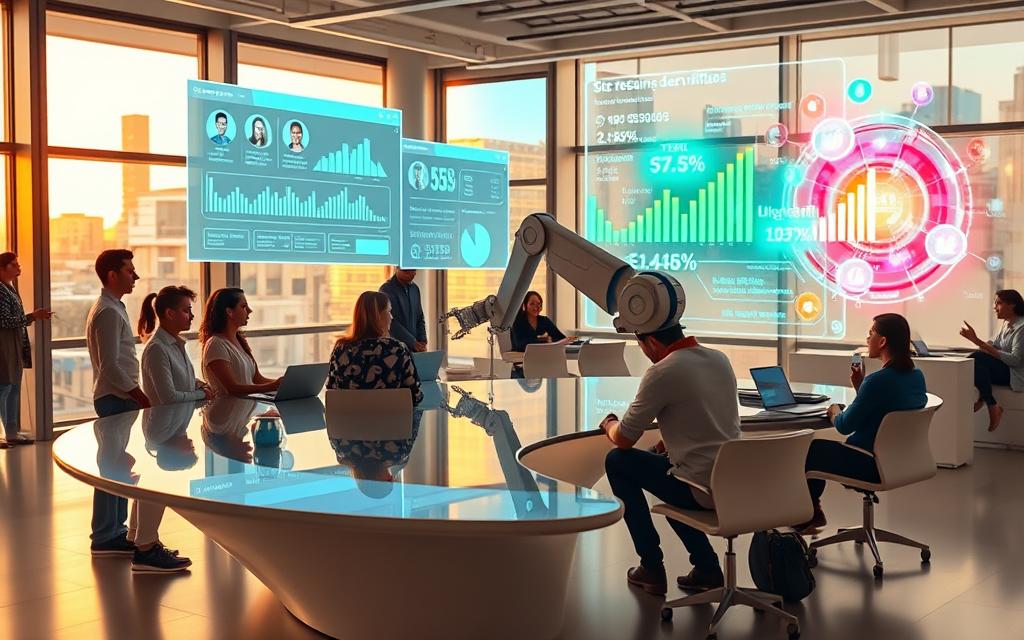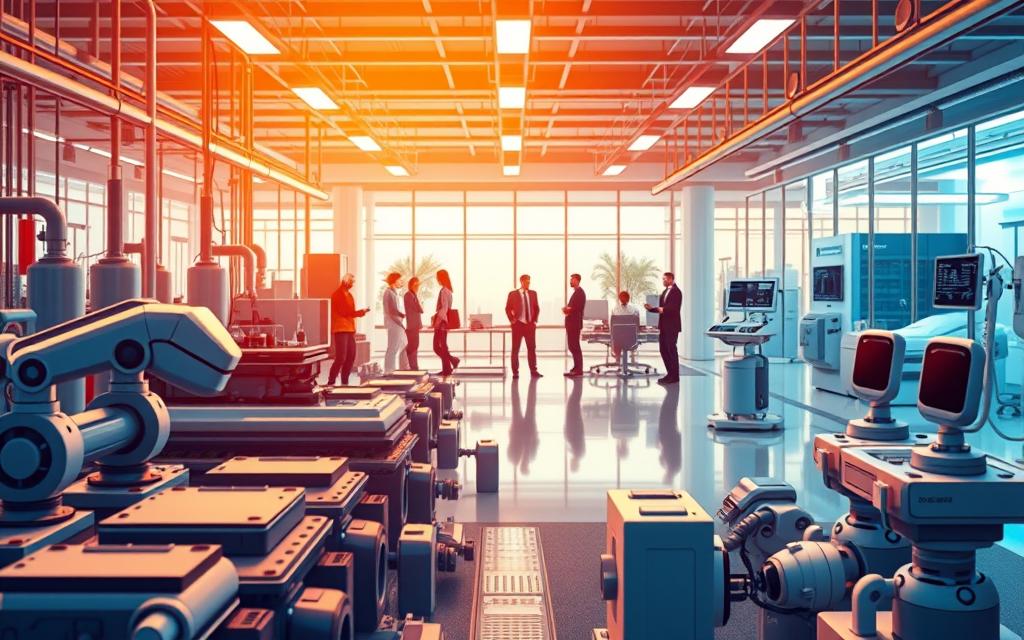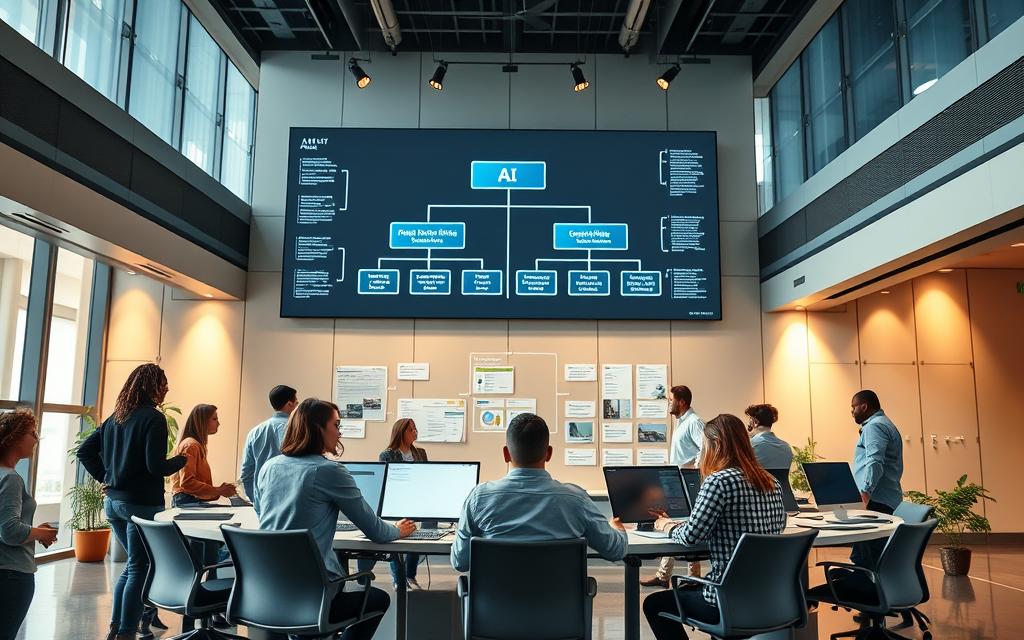Table of Contents
Technology continues to reshape industries, and artificial intelligence leads the charge. Companies now leverage AI to boost productivity, streamline operations, and enhance customer experiences. From retail to healthcare, this innovation drives measurable success.
Recent data highlights rapid adoption. A Forbes survey found 73% of firms use AI chatbots for interactions. McKinsey reports firms embracing AI see 63% higher revenue growth. Efficiency gains could reach 10x by 2024, per Gartner.
Yet challenges remain. Ethical concerns and workforce impacts require attention. This article explores real-world applications, benefits, and key considerations for forward-thinking organizations.
The Rise of AI Adoption in Business Operations
Corporate strategies now pivot around AI-driven efficiencies. Companies report measurable gains, from cost savings to enhanced decision-making. Research confirms this shift: IBM predicts AI will handle most customer interactions by 2024.
Key Drivers Behind AI Integration
Cost reduction tops the list. Over 53% of firms optimize production processes using AI. Risk mitigation follows, with 51% deploying AI for fraud detection.
ROI fuels adoption. Microsoft and IDC found every $1 invested in generative AI yields $3.70. Accenture notes AI doubles workforce efficiency in targeted tasks.
Survey Insights: Adoption Rates Across Industries
Retail leads at 73% adoption, leveraging AI for demand forecasting. Manufacturing lags at 35%, slowed by legacy systems.
Customer service sees 56% AI integration, while supply chains hit 40%. Cybersecurity tools now use AI in 51% of cases.
“Generative AI delivers the highest ROI in automation history.”
How Businesses Are Using Artificial Intelligence in 2024: Key Applications
Forward-thinking firms now harness AI to solve real-world challenges. From instant customer support to fraud prevention, these tools redefine business processes. Below are three critical areas where adoption surges.
Revolutionizing Customer Service
Chatbots handle 73% of inquiries, slashing wait times by 56%. Urban Company’s AI resolves 85–90% of queries without human agents. Key benefits:
- 24/7 availability with consistent responses
- Multilingual support for global audiences
- McDonald’s China processes 30,000 monthly AI transactions
Fortifying Cybersecurity
Pattern-recognition algorithms cut fraud losses by 51%. Bank of Queensland saves 5 hours weekly per employee through automated threat detection. Microsoft’s Azure AI reviews 150 meetings/hour for risks.
Optimizing Supply Chains
Walmart reduced stockouts by 30% using AI-powered inventory management. Demand forecasting now sees 40% adoption, per Gartner. Trilegal’s document AI cuts legal review time by half.
“AI-driven automation isn’t optional—it’s the backbone of competitive supply chains.”
AI-Driven Productivity Gains: By the Numbers
The measurable impact of AI on corporate performance is reshaping benchmarks. From revenue growth to time savings, data reveals staggering improvements. Industry leaders now set new standards using these insights.
Revenue Growth Across Industries
McKinsey’s research shows a 63% average revenue increase for early AI adopters. Sector-specific results vary:
- Retail: 72% growth from demand forecasting AI
- Finance: 58% boost via fraud detection algorithms
- Healthcare: 41% rise with diagnostic support tools
Profitability Projections
Accenture predicts a 38% profitability surge by 2025. Key drivers include:
- Automated workflows (51% adoption in manufacturing)
- Generative AI for text (63% ROI vs. 26% for code creation)
“AI adoption isn’t just about cost-cutting—it’s a revenue multiplier.”
Efficiency Breakthroughs
Gartner’s 10x efficiency claim aligns with real-world results:
- Honeywell employees save 74 hours yearly through AI tools
- Canadian Tire’s ChatCTC cuts daily task time by 30–60 minutes
- Campari Group reports 2-hour weekly savings per employee
Despite gains, 35% of firms face skill gaps. EPAM’s workflow consolidation shows how AI mitigates this by reducing redundant tasks.
Transforming Talent Acquisition with AI
Modern talent acquisition relies on data-driven AI tools. These solutions streamline hiring while reducing bias. Leading report significant time savings and improved candidate matches.

Algorithmic Candidate Screening
AI now powers 80% more accurate resume analysis than manual reviews. Unilever processes 25,000 monthly candidates through video interview AI. Key benefits include:
- 53% faster hiring cycles (PwC data)
- Reduced human bias in initial screenings
- Automated skills verification for technical roles
| Tool | Feature | Impact |
|---|---|---|
| Harvey AI | Legal task automation | 10 hrs/week saved |
| SkillsGPT | Competency mapping | Identifies 92% of emerging needs |
| PwC Attrition AI | Turnover prediction | 25% reduction rate |
Predictive Workforce Models
Advanced systems forecast staffing needs with 89% accuracy. Maire engineering saved 800+ monthly hours through workflow AI. Bancolombia achieves 42 daily deployments via automated code generation.
These models help teams make better about:
- Promotion pipelines
- Department restructuring
- Training budget allocation
Skills Gap Analysis
Machine identifies missing competencies across organizations. LGT Bank’s pilot program shows 1-hour weekly savings per employee. Key applications include:
- Personalized upskilling paths
- Future role preparedness scoring
- Team capability benchmarking
“AI-powered skills analysis cuts training costs by 30% while improving workforce readiness.”
Ethical considerations remain critical. Regular audits ensure algorithms avoid demographic bias. When implemented responsibly, these tools create fairer, more efficient environments.
Revolutionizing Customer Experience Through AI
Brands now deliver seamless interactions using smart tools. These innovations transform how customers engage with services, creating frictionless journeys. AI-powered solutions analyze behavior patterns to anticipate needs before they arise.
Chatbots Redefine Instant Support
With 73% adoption, AI chatbots handle routine inquiries efficiently. Nykaa’s virtual assistant accelerates product launches by 20%, while SPAR saves 715 hours monthly. Key advantages include:
- Round-the-clock availability with consistent accuracy
- Multilingual capabilities for diverse audiences
- AXA’s Secure GPT ensures compliant financial interactions
“AI-driven chatbots cut response times by 68% while maintaining quality standards.”
Hyper-Personalized Recommendations
Sephora’s AI suggestions boost sales by 35% through tailored product matches. Coca-Cola’s generated marketing copy performs 40% better than human-written versions. Personalization strategies now drive 55% higher conversion rates.
Optimized Digital Communications
Natural language processing enhances email and text interactions. BMW’s predictive maintenance alerts reduce unnecessary service visits by 32%. E.ON’s real-time grid management improves reliability through data-driven adjustments.
These advancements prove that customer experience thrives when technology meets human-centric design. Brands investing in these tools gain measurable competitive advantages.
AI in Content Creation and Marketing
Creative teams now leverage AI to push boundaries in digital storytelling. These technologies enable hyper-personalized experiences while slashing production . From dynamic ads to multilingual campaigns, innovation reshapes engagement strategies.
Automated Long-Form Content Generation
Marketing departments report 42% adoption of AI writing tools. Cactus Communications achieves 15-20% efficiency gains in research paper drafting. Wipro accelerates technical documentation through GitHub Copilot integration.
Key benefits driving adoption:
- BuzzFeed’s AI quizzes generate 35% more engagement than traditional formats
- L’Oréal’s trend forecasting achieves 89% accuracy using predictive algorithms
- Ethical frameworks prevent misinformation in generated articles
Dynamic Advertising Personalization
Nike’s AI-powered ads deliver 28% higher CTR through real-time customization. Adobe Experience Cloud users launch campaigns 40% faster with automated asset generation.
“Personalized ad spend yields 46% ROI—outperforming static campaigns by 3x.”
The thrives on -driven creative variations:
- Seasonal product placements adjusted by weather patterns
- Dynamic pricing reflected in real-time ad copies
- User behavior-triggered messaging sequences
Multilingual Content Scaling Strategies
Microsoft supports 140+ languages through neural translation tools. Localization costs drop by 60% while maintaining brand voice consistency.
Pioneering achieve global reach through:
- AI-dubbed video content with lip-sync accuracy
- Cultural adaptation algorithms for regional nuances
- Automated compliance checks for international regulations
These advancements prove that content creation evolves when human creativity combines with machine precision. The future belongs to teams mastering this synergy.
Operational Efficiency: AI in Business Processes
Companies achieve remarkable productivity gains by integrating AI into daily operations. These technologies streamline workflows, reduce errors, and free up valuable time for strategic tasks. Across industries, measurable results prove the transformative power of intelligent automation.
Manufacturing Process Optimization
Over 53% of manufacturers now use AI to refine production lines. John Deere’s quality control system slashes defects by 40% through real-time visual inspections. Eaton’s AI-powered documentation tools cut SOP creation from 1 hour to 10 minutes.
Key benefits driving adoption:
- Predictive maintenance reduces equipment downtime by 35%
- DHL’s route optimization AI saves 15% in fuel costs
- Noventiq saved 989 hours in four weeks using Copilot for repetitive tasks
Back-Office Automation Breakthroughs
Task automation now handles 51% of routine work in administrative functions. Localiza&Co reports 8.3 hours saved monthly per employee through AI document processing. Data entry errors drop by 68% when using intelligent form recognition.
“AI doesn’t replace workers—it amplifies their capabilities by eliminating mundane tasks.”
Digital Visibility Enhancements
SEO tools powered by machine learning boost organic traffic by 52%. These solutions analyze search patterns to optimize content strategies. Key applications include:
- Automated keyword clustering for topic authority
- Competitor gap analysis with real-time alerts
- Performance forecasting based on historical
For deeper insights on transforming , explore our AI implementation guide. The data proves that operational separates industry leaders from competitors.
Industry-Specific AI Implementations
Industry leaders now tailor AI solutions to sector-specific challenges. Custom algorithms address unique pain points, from retail stockouts to life-saving diagnostics. These targeted applications prove that one-size-fits-all approaches no longer suffice.

Retail: Demand Forecasting and Inventory AI
Walmart’s AI-powered supply chain slashed inventory costs by 30% through real-time demand predictions. Target reduced out-of-stocks by 50% using restocking algorithms. Key innovations include:
- Dynamic pricing adjusting to trends
- Nestlé’s 15% demand sensing accuracy boost
- Automated warehouse robots cutting fulfillment errors by 40%
Healthcare: Diagnostic Support Systems
Mayo Clinic’s AI tools improved diagnostic accuracy by 35%, while Siemens Healthineers accelerated MRI analysis by 20%. Cleveland Clinic’s sepsis detection AI saved hundreds of lives annually.
“AI doesn’t replace doctors—it amplifies their expertise with data-driven insights.”
Finance: Real-Time Fraud Detection Networks
Visa’s AI blocks $25B in fraudulent transactions yearly. JPMorgan’s COIN platform saved 360,000 lawyer hours through contract review automation. Other breakthroughs:
- 90% of loan applications processed without human intervention
- Algorithmic trading reducing latency by 74%
- Chatbots handling 80% of routine inquiries
These examples showcase AI’s transformative power when aligned with industry needs. For deeper insights into AI-driven supply chain innovations, explore emerging tech synergies.
Generative AI’s Expanding Role in Enterprises
Enterprises now push boundaries with generative technologies, moving beyond simple automation. These advanced models create text, code, and multimedia—transforming how companies operate. From marketing to R&D, the impact is measurable and growing.
Transforming Written Communication
AI writing assistants see 63% adoption across industries. Morgan Stanley analyzes 160,000 research documents in seconds using natural language processing. Coca-Cola tests AI-generated ad variants, achieving 40% better performance than human-created versions.
Key benefits driving this shift:
- Legal teams save 10 hours weekly with automated contract drafting
- P&G’s packaging designs reduce material waste by 15% through AI optimization
- Voice cloning enables personalized customer service at scale
Revolutionizing Software Development
GitHub Copilot users code 55% faster, with 26% fewer quality issues. Wipro integrates AI tools across development cycles, slashing project timelines. The results speak volumes:
| Tool | Application | Impact |
|---|---|---|
| Amazon CodeWhisperer | Real-time suggestions | 38% faster debugging |
| Tabnine | Code completion | 50% less repetitive typing |
| Replit Ghostwriter | Collaborative coding | 60% onboarding acceleration |
“Generative coding tools don’t replace developers—they amplify creative problem-solving.”
Multimedia Production at Scale
Canva’s Magic Design generates 1 million+ images daily, while WPP cuts video production costs by 40% using AI. NVIDIA’s platforms accelerate drug discovery through molecular simulation. Yet ethical concerns remain:
- Deepfake detection tools combat misinformation
- Watermarking ensures AI-generated content transparency
- Creative industries establish guidelines for responsible use
These advancements prove generative AI’s potential when balanced with thoughtful implementation. The future belongs to enterprises harnessing this innovation strategically.
Organizational Changes for AI Success
Successful AI integration demands structural evolution. Leaders must rethink governance, workflows, and deployment models to maximize value. Research shows companies adapting their processes see 3x higher returns than those forcing AI into existing frameworks.

Executive Leadership in AI Strategy
McKinsey reveals 28% of top-performing firms have CEO-led AI governance. This approach correlates with 20% higher EBIT impact. Unilever’s centralized model delivered 300% ROI through coordinated decision-making.
Key elements of effective governance:
- Cross-functional AI councils (Siemens improved decision speed by 50%)
- Clear ethics frameworks (PwC’s committee structure prevents bias)
- Executive KPI alignment (BP ties leadership bonuses to AI adoption metrics)
Workflow Transformation Tactics
Only 21% of organizations redesigned workflows for AI integration. Those that did achieved dramatic results:
- Maersk saved 15,000 annual hours through process automation
- Microsoft’s Copilot framework reduced meeting prep time by 40%
- Failed implementations often stem from unchanged legacy processes
“Workflow redesign isn’t optional—it’s the foundation for AI success.”
Deployment Architecture Choices
Companies face critical decisions between centralized and hybrid models:
Centralized Approach
- Standardized tools across departments
- Higher initial investment (Accenture committed $3B to training)
- Easier compliance management
Hybrid Model
- BP’s cloud-based AI services adapt to regional needs
- Faster departmental adoption
- Requires strong integration protocols
The right choice depends on organizational size, skills availability, and strategic goals. Successful firms balance flexibility with governance.
Addressing AI Implementation Challenges
While AI delivers transformative benefits, implementation hurdles require strategic solutions. Organizations report three dominant concerns: workforce readiness, data protection, and algorithmic fairness. Proactive measures turn these challenges into competitive advantages.
Closing the Skills Gap Through Strategic Upskilling
A 35% skills shortage tops adoption barriers. Amazon’s $700M training initiative upskilled 300,000 employees in cloud and ML technologies. Key results:
- Internal mobility increased by 25% among trained staff
- Project delivery accelerated by 18% through certified teams
- EU firms now mandate 40 annual training hours under the AI Act
Mitigating Data Privacy and Security Risks
31% of healthcare providers delay AI adoption over privacy concerns. IBM’s encrypted learning models reduce exposure by processing sensitive data locally. Critical safeguards include:
- Anonymization techniques that preserve 92% of dataset utility
- Real-time monitoring for data poisoning attempts
- Microsoft’s Confidential Computing framework for healthcare AI
| Challenge | Solution | Impact |
|---|---|---|
| Regulatory compliance | EU AI Act alignment tools | 60% faster audits |
| Model bias | IBM’s Fairness 360 Toolkit | 78% fairness improvement |
| Security breaches | MIT’s AI Shield | $50M risk reduction |
Ensuring Fair Algorithmic Decisions
Facial recognition lawsuits revealed 34% higher error rates for minority groups. Microsoft’s Responsible AI framework now powers ethical review boards. Proven approaches:
- Diverse training datasets reducing bias by 45%
- Continuous monitoring for discriminatory patterns
- Public scorecards for transparency
“Bias detection algorithms must evolve alongside AI systems to prevent harmful decisions.”
These measures demonstrate that thoughtful implementation outweighs adoption risks. Companies addressing these challenges lead in both innovation and trust.
The Workforce Impact Debate
The rise of AI sparks heated discussions about its workforce consequences. While 38% of companies expect no headcount changes, 77% of consumers fear job losses. This tension between productivity gains and employment stability defines today’s labor .

Job Displacement Fears and Realities
Research reveals 33% of businesses delay AI adoption over workforce concerns. Yet data suggests a nuanced picture:
- McKinsey found 63% of displaced workers transition successfully to new roles
- Creative destruction affects legacy industries, but UPS creates drone technician positions
- Amazon increased ML specialist hires by 300%, offsetting automation losses
“AI won’t eliminate jobs—it will redefine them. Our research shows net employment growth when reskilling investments match tech adoption.”
Reskilling Initiatives Transforming Industries
Progressive invest heavily in workforce development:
| Program | Scale | Outcome |
|---|---|---|
| AT&T Reskilling | 100,000 employees | 85% retention rate |
| Siemens Certifications | 5,000 prompt engineers | 40% faster AI deployment |
These initiatives prove that skills adaptation can turn disruption into opportunity. The future belongs to organizations prioritizing continuous learning.
Emerging AI Specialist Roles
New positions reshape the employment landscape:
- AI trainers refine model accuracy through feedback loops
- Ethicists ensure responsible algorithm development
- Maintenance specialists oversee autonomous systems
The World Economic Forum predicts 97 million new AI roles by 2025. This counters displacement fears, creating net-positive opportunities for adaptable professionals.
Future-Proofing with AI: 2025 and Beyond
Agentic systems mark a paradigm shift in autonomous decision-making. These advanced technologies evolve through real-time feedback loops, achieving 90% task independence in Microsoft’s prototypes. Gartner predicts 80% of enterprises will deploy such systems by 2026.
The rewards early adopters. BCG projects manufacturing AI will deliver 200% ROI by 2025. Healthcare and energy sectors follow closely with 175% and 160% growth respectively.
Autonomous Systems Redefining Possibilities
Microsoft’s experimental agents now handle multi-step procurement processes with minimal oversight. Key breakthroughs include:
- Self-correcting supply chain algorithms at Walmart
- NVIDIA’s quantum machine learning for material science
- Verizon’s 5G-powered edge computing networks
Meta’s embodied AI research bridges digital and physical tasks. Their prototype robots adapt tools in unstructured environments—a capability previously requiring human technicians.
ROI Acceleration Patterns
| Sector | 2024 ROI | 2025 Projection |
|---|---|---|
| Pharmaceuticals | $2.80 | $4.10 |
| Retail | $3.20 | $4.80 |
| Energy | $2.10 | $3.70 |
Pfizer’s drug discovery pipeline exemplifies this trend. Their AI platform cut compound screening time from months to hours while improving accuracy.
Sector-Specific Innovation Roadmaps
Walmart’s GenAI shopping assistants now process natural language requests with 94% accuracy. Meanwhile, climate modeling algorithms help energy firms:
- Predict grid failures 72 hours in advance
- Optimize renewable asset placement
- Reduce carbon capture costs by 35%
“The next decade belongs to organizations blending human creativity with machine autonomy.”
Ethical frameworks remain critical as these innovations advance. Responsible development ensures AI serves both objectives and societal needs.
Conclusion: Balancing Innovation With Responsibility
The future belongs to organizations that harness AI’s power while upholding ethical standards. Leaders report 63% revenue growth from strategic adoption, with customer service automation reaching 56% efficiency gains.
Successful cases like SPAR and Urban Company prove AI’s transformative impact. Yet 35% of firms now implement bias mitigation tools, reflecting growing responsibility.
Two priorities emerge: continuous learning for workforce transitions and transparent data practices. Microsoft’s $3.70 ROI benchmark shows the rewards of balanced implementation.
Regulatory focus intensifies as agentic AI advances. Complacency risks irrelevance—proactive firms will lead the innovation race while building trust.
FAQ
What are the top applications of AI in business today?
Leading uses include customer service automation (56%), cybersecurity (51%), and supply chain optimization (40%). Companies also leverage AI for content creation, marketing personalization, and workflow automation.
How does AI improve operational efficiency?
AI enhances productivity by automating repetitive tasks, optimizing inventory management, and refining production processes. McKinsey reports adopters see 63% higher revenue growth compared to non-adopters.
Are chatbots replacing human customer service teams?
While 73% of firms use chatbots for instant responses, most deploy them alongside human agents. AI handles routine queries, freeing staff for complex issues requiring emotional intelligence.
What industries benefit most from AI adoption?
Retail uses AI for demand forecasting, healthcare for diagnostic support, and finance for fraud detection. Each sector tailors solutions to its specific operational needs and compliance requirements.
What challenges do companies face with AI implementation?
Common hurdles include skill gaps (35% of firms), data security risks (31%), and algorithmic bias. Successful deployments require robust training programs and ethical governance frameworks.
How is generative AI transforming content creation?
Enterprises use text generation tools (63% adoption) for drafting marketing copy, while 26% apply AI for coding assistance. Multimedia production and multilingual content scaling are growing applications.
Will AI eliminate jobs or create new opportunities?
While 33% of organizations anticipate some role displacement, more focus on reskilling programs. Emerging positions like AI trainers and ethics specialists offset potential job losses.
What metrics prove AI’s return on investment?
Key indicators include 38% higher profitability (Accenture), reduced operational costs, and improved customer satisfaction scores. Early adopters typically recoup implementation costs within 12-18 months.
How do companies address AI bias concerns?
Leading firms audit algorithms regularly, diversify training data sets, and establish cross-functional review teams. Transparency in decision-making processes builds stakeholder trust.
What emerging AI trends should businesses watch?
Agentic AI systems capable of autonomous decision-making, industry-specific large language models, and real-time supply chain adaptations represent the next wave of innovation.









